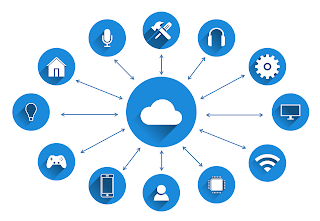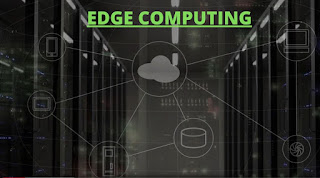Cloud and Edge computing : simplified facts 2022
1.Cloud Computing Simplified
Cloud computing is a term used to describe the large-scale deployment of high-performance computing and other forms of software and hardware resources on a network .Cloud computing is used to create an environment in which distributed and virtualized resources can be accessed via a computer’s Internet connection. This typically allows the computer to connect to multiple computers . It allows the user to perform calculations with multiple different computers simultaneously.
Cloud computing is an emerging technology that has been defined by several different IT industry definitions. It represents a shifting of the traditional line between data center and cloud computing by extending this connection through virtualization, as well as by applying software as a service (SaaS) technologies like Web services . The term cloud computing can also refer specifically to shared storage services, such as Google’s Drive .
It has become increasingly common for businesses to use cloud computing . They need to own their data storage needs Company use cloud computing also for their customers own applications. The increasing demand for these services will see continued growth in the number of companies using them . Specially those in high growth markets such as financial services and healthcare. Many companies are also experimenting with hybrid approaches . This combine both on-premises applications with cloud offerings . The ability to scale up and down capacity at will gives organizations access to vast amounts of resources at low cost . It allows them more control over where, when and how they use them. It also increases their ability to operate anywhere in their geography while lowering costs . As they do not have physical infrastructure between themselves and their users . But they rely on dedicated servers running on public Internet connections . These internet connections with minimal bandwidth requirements.
In recent years we have seen many examples of enterprise usage of cloud computing . These are Amazon Web Services or Microsoft Azure. These are being used by thousands of organizations across Europe, Asia Pacific and North America .There are two main types of cloud computing . Public cloud , where customers pay on an hourly basis for “whole server” (e.g., Microsoft Azure) or “attached” (e.g., Amazon EC2) hosting . Private clouds where companies choose what kind of hardware they want installed . For example Amazon EC2 instances or Microsoft Azure Stack instances .
Some organizations choose to couple private clouds with on-premise systems through virtualization technology . Some examples are VMware or vSphere . Others choose another type of technology (e.g., Citrix XenServer). Some organizations might even use both types depending upon their needs .
2. Cloud computing and its market
Cloud computing is a huge and fast-growing market. It is the deployment of computing resources that are invisible to the user. The term “cloud” refers to a large group of IT resources that are hosted, managed, and administered by a central provider. Cloud technology makes it possible for various providers to offer their software as a service (SaaS) .
Cloud computing enables organizations to manage and provision cloud-based applications and services across the globe, allowing users to access the information they need whenever they need it through an intuitive interface. Cloud computing has been in existence since its inception in 1998 when Bill Gates first presented his ‘cloud model’ . In 2006, Amazon Web Services announced their public cloud offering which was designed for small businesses. In 2010, Microsoft released their Azure platform which was considered as one of the largest public clouds available at that time.
3. Cloud Computing versus Edge Computing
Let us approach the topic of cloud computing and edge computing . It is important to understand that they are not so much different as they are complimentary. Cloud computing is a storage model in which data is stored on a network of servers and multiple sources of connectivity to the network. The term “cloud” refers to a specific set of technologies that make up this infrastructure.
Cloud computing is named for its analogy to clouds in nature. A cloud, when viewed from above, looks like an expanding fog or haze-like sheet or sheet of water that appears stationary from the perspective of any given point in space . Edge computing is a technology that can be implemented at any point on the internet backbone, but where digital information is accessed from physical devices (such as mobile phones) rather than from a central server. In both cases, data is processed closer to where it’s generated and controlled by end users.
4. Edge computing and its benefits
Edge computing technology is a form of distributed computing in which data is processed at the edge of the network . It is as close to the originating source as possible. Described by researchers from IBM and Michigan State University, edge computing is a distributed system .
Edge computing systems are designed to minimize network latency, reduce costs and time for processing information, and increase the availability of data. The term edge computing refers to applications that require quick access to large amounts of data across a wide area network (WAN) or Internet. Edge computing systems can be deployed on-premise or off-premise.
Cloud also refers to an environment where users access services on demand from an external provider .
By definition, cloud means an environment where you can pay only for what you use , no matter how much you are using it . More on Edge Computing : https://en.wikipedia.org/wiki/Edge_computing
5. Challenges in Edge computing
Edge computing architecture is one of the key technologies . This enables us to reach into the data center and do work closer to where the data is being created . Shifting of Network bandwidth is the key challenge when an enterprise moves and compute data to edge computing .
The key advantage of edge computing is that we can create a certain type of virtualized environment . In this applications can run on cloud platforms with reduced latency, lower costs and better availability. This removes latency issues, some of the biggest problems faced by enterprises as they move their workloads closer to where they are created .
Edge computing creates a hybrid cloud . Here applications run on traditional server farms and manage workloads in the data center from edge locations. Applications are deployed using cloud-based technologies such as Amazon EC2 or Microsoft Azure. This allows enterprises to reduce the cost of their IT operations . And It reduce potential risk by keeping their workloads close to where it’s being created . Edge computing allows for faster application delivery, less disruption for users as applications . Edge Computing reduces latency issues . Edge computing also allows for increased security by isolating sensitive data from unauthorized access . It allows businesses to more easily achieve compliance standards established through regulatory bodies . These are FISMA (Financial Industry Regulatory Authority) , HIPAA (Health Insurance Portability and Accountability Act) and HIPAA Security Rule (45 C.F.R.)
Edge computing will allow companies to swiftly deploy applications that require more processing power than traditional servers . while still maintaining confidence in web-scale architectures with minimal disruption for end users. Security and Accessibility is one of major challenge in Edge Computing .This technology will enable companies to provide a new paradigm shift in how we think about what happens in our business ecosystems . Every aspect is connected and brought together at source rather than spread out throughout multiple data centers all over the world so that we can securely share our critical information online without fear of data theft or other security breaches.
6. IoT Edge computing
Edge computing is a form of cloud computing that allows efficiency in the processing of data across multiple computers . Edge computing is a set of technologies that are used to process data at the edge of the network . And move it away from central hosts as close to the source as possible. The primary method used for edge computing is Application-to-Application (A2A) technology. Advantages include low latency, high scalability and minimal connectivity requirements . It makes edge computing suitable for applications such as video surveillance and augmented reality systems .
IoT Edge computing is a pejorative term used to refer to IoT applications which use edge devices (such as sensors, actuators and cameras) connected to servers . These are located near the endpoints they are intended to monitor or control. Cloud Computing refers to computer services provided by cloud providers without any physical location, but rather by being accessed remotely via a network .
Edge Computing (EC) refers to hardware and software platforms that support off-premise networks . It support network through networking gateways . There are several different classes of EC products : sensor nodes , edge-routers , end-user networks , low energy computing and smart grid . Differentiating between EC systems based on their physical location has resulted in numerous differing names: “edge” computing vs “edge networks” vs “operations center” vs “edge infrastructures” .
IoT Edge Computing consists of three parts: sensor nodes (base station), edge routers (network switches) and end users (hosts). They are referred to as an IoT Edge Network. IoT Edge Networks consist of several types of network components including base stations , switches, WAN routers , etc . The main differences between IoT Edge Networks formed by different vendors can be summarized in three categories . Single-Site or Single-Hub Network – A single site with one switch or router per device – Typically used for consumer electronics devices – Single Hub Controller – A single hub with one controller per device – Used for industrial applications such as smart factories, medical devices or industrial robotics – Multi Hub Controller – A hub with 2 controllers per device – each controller supports multiple sensors/actuators/devices within its local area network (LAN) – often used for industrial applications where many sensors/actuators need remote control over each other’s activities Network Topology – Indirect control over sensors via multiple hubs/switches/reactors – Device is not directly connected .
7. Conclusion
Cloud computing is a popular term for the Internet of Things (IoT) . It involves applications and services that are cloud-enabled . Cloud computing also refers to applications that are hosted on the Internet, as opposed to on physical hardware.
Edge computing is similar to cloud computing, but with more emphasis on data center resources. Edge computing is defined by the concept of edge servers . Edge computing servers are closer to the resources being processed than traditional servers.
Cloud computing has become incredibly popular over the last decade because it allows enterprises to cut costs . It can be done by eliminating floor space, handling operational and security risks outside of the IT department’s control, and providing all applications over a single platform . This has improved transparency and reduced costs . However, there are still many challenges associated with cloud technology which have led many businesses to continue looking for ways to improve their operations in a more secure environment. Edge computing too has few challenges ,which needs to be eliminated .





Very Informative article
Thank you